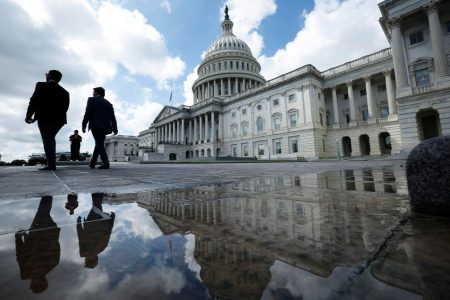Tax Notes managing legal reporter Andrew Velarde breaks down the Supreme Court’s decision in Moore v. United States and its implications for the future of tax.
This transcript has been edited for length and clarity.
David D. Stewart: Welcome to the podcast. I’m David Stewart, editor in chief of Tax Notes Today International. This week: no more Moore.
The Supreme Court has released a decision ending the saga of Moore v. U.S., a case that we’ve covered in several episodes, which we’ll link to in the show notes. So how did the Court decide?
Here to talk more about this is Tax Notes managing legal reporter, Andrew Velarde. Andrew, welcome back to the podcast.
Andrew Velarde: Thanks, Dave. It’s good to be back.
David D. Stewart: Now, I know we’ve talked about this several times before. Before we get into what happened in this decision, could you give us some background?
Andrew Velarde: Sure. The Moores were seeking a $15,000 refund on taxes paid on undistributed earnings from an Indian-controlled foreign corporation of which they were minority owners. They challenged the constitutionality of the section 965 transition tax, also known as the mandatory repatriation tax, or MRT for short, that’s levied on the taxpayer’s post-1986 accumulated foreign earnings, and it was enacted under the Tax Cuts and Jobs Act in 2017.
The Moores argued that it is a direct tax and therefore unconstitutional because it is not subject to apportionment. The Ninth Circuit affirmed a district court’s decision to reject the challenge. It also rejected the Moores’ due process challenge. The appellate court said that the courts have consistently held that taxes like the transition tax are constitutional and that whether income is realized is not determinative.
Now under the 16th Amendment, income taxes can be collected without apportionment, apportionment essentially being dividing it up amongst the states. Apportionment would be impractical if not impossible for many taxes. Then the question becomes, what is needed for something to be income to avoid this apportionment requirement?
Now, the Moores consistently argued that income has a realization requirement. The transition tax is not a tax on income, they argued, but rather one on property and thus must be apportioned. Their argument was that they never realized the income from their Indian CFC and the transition tax taxed the offshore income regardless of whether it was distributed to shareholders. They argued the transition tax is unique because it doesn’t rely on “constructive realization of income,” that’s their term, by those being taxed and instead relates back to the ownership of a specified asset at a specified point in time.
Now, the Moores appealed to the Supreme Court on the income realization issue, but not the due process issue, and the Supreme Court granted cert last June and heard oral arguments in December. Knowing the importance of this case to the tax system, dozens of amicus briefs were filed in this case on both sides.
Now, the potential fallout from this case could have been huge. The transition tax primarily targeted large corporations, and the Joint Committee on Taxation estimated it would bring in $340 billion over 10 years. But it goes beyond that. Many observers speculated that a ruling in favor of the Moores could endanger many other long-standing tax provisions. We’ll get more on that later.
David D. Stewart: So the oral arguments happened in December. You covered them for us. Did they offer any clues as to how this case was coming out?
Andrew Velarde: Yes, I think they did. During oral arguments, it seemed that many of the justices may have been looking for a narrow way out of directly ruling on the biggest issue in this case, namely, does income have a realization requirement? That ended up being exactly what happened. But that’s not to say that this decision wasn’t still very significant.
David D. Stewart: All right, so let’s talk about this decision. What did the Court hold?
Andrew Velarde: On June 20 the Court ruled in favor of the government in a 7-2 decision, which included two concurrences, and it upheld the Ninth Circuit decision and the constitutionality of the transition tax. It held that Congress has the power to tax either an entity or its shareholders or partners, and the tax will remain a tax on income regardless of Congress’s choice. It looked to the lengthy history of similar taxation in other provisions of the code for support. The decision authored by Justice Kavanaugh was interesting in how forcefully it caveated the opinion was limited to its facts. I’d like to read a quote from that opinion now.
It says, “Congress has long taxed shareholders of an entity on the entity’s undistributed income, and it did the same with the MRT. This Court has long upheld taxes of that kind, and we do the same today with the MRT. Nothing in this opinion should be read to authorize any hypothetical congressional effort to tax both an entity and its shareholders or partners on the same undistributed income realized by the entity. In such a scenario, the entity would not simply be a traditional pass-through.”
Perhaps most importantly for the majority was that the Moores’ company did unquestionably realize income, and thus, the transition tax was levied on realized income. The transition tax then attributed the undistributed income of the corporation to shareholders like the Moores. So because it was a question of attribution, the Court thus did not need to answer the question of whether income had a realization requirement.
David D. Stewart: You alluded to the Court’s discussion of having a long history of taxing shareholders and partners on undistributed income. What did they have to say on that?
Andrew Velarde: This was a big part of the opinion. The Court compared the transition tax to several other provisions of the code, which the Moores had tried unsuccessfully to distinguish from. These are the words of Kavanaugh. They did that so that they could “contain the blast radius of their legal theory.” Now this included partner shares of partnership profits, S corporation taxation, and the taxation of U.S. shareholders of foreign entities and CFCs under subpart F.
Here’s another quote from the court: “The Moores have advanced an array of ad hoc distinctions to try and explain why those longstanding taxes are constitutional and why those precedents are correct and to simultaneously try to explain why those taxes and precedents do not eviscerate their argument that the MRT is unconstitutional. But the Moores’ effort to thread that needle, although inventive, is unavailing.”
So the similarities between the transition tax and the subpart F in particular were significant for the Court. The Moores argued that subpart F related to, as I said before, constructive realization, but the court said that term was a “one-off label woven out of whole cloth.” Subpart F was not limited to mobile income despite the Moores’ contention, and it was set at the same level of shareholder control as the transition tax. If one were to accept the Moores’ argument on realization, the Court said that huge chunks of the code would be unconstitutional and trillions of tax revenue would be lost.
In addition to the earlier mentioned provisions, the Court also said provisions such as section 305 on deemed stock distributions, accrual accounting, the global intangible low-taxed income provision, section 1256 on futures contracts, section 1272 on original issued discount instruments, and gift taxes could be endangered.
David D. Stewart: In the run-up to this case, there was a lot of discussion about a very old Supreme Court precedent. Did the decision address that?
Andrew Velarde: Well — yes and no — if I’m not being too perplexing. You were referring to the 1920 case Eisner v. Macomber, a case that every law student studying tax has read. There, the Supreme Court held that a stock dividend was not subject to tax under the 16th Amendment. The Moores pointed to that case for holding that income requires realization. But the Court, while recognizing the decision, held that the Moores’ reliance on it was misplaced since other later Supreme Court decisions directly addressed attribution and allowed it while Macomber did not.
David D. Stewart: A lot of people were looking to this case to read the tea leaves for the future. Are there any takeaways from this case for the future of taxation that we can glean from it?
Andrew Velarde: Yes, Dave, I think that’s the most interesting question here and one of the most interesting takeaways. Several of the practitioners I talked to think that the Court is sending a message to Congress not to stray too far from its traditional avenues of taxation. A footnote from the Court in the opinion says the decision does not address issues that could be raised if Congress tried to tax the entity and shareholders or partners on undistributed income, tax holdings or wealth, or appreciation.
David D. Stewart: There had been a lot of chatter about that the Supreme Court might take this as an opportunity to preemptively strike down the idea of a wealth tax. What can we read into this decision on that?
Andrew Velarde: So a wealth tax has been one of the most discussed issues lurking in the background in Moore. The majority opinion made sure to note that a wealth tax might be considered a tax on property and not income and cited the government’s own positions in brief and in oral arguments that presented a hypothetical tax as such. Justice Barrett, in a concurrence joined by Justice Alito, and Justice Thomas, in a dissent joined by Justice Gorsuch, both argue that income does have a realization requirement.
Given that, several practitioners that I spoke with said that the Court seemed to be hinting that any future wealth tax could be struck down as unconstitutional for its failure to tax realized gains. Even though the majority didn’t outright endorse a realization requirement, only one other justice in that voting block would need to come down in that camp to potentially kill a wealth tax. Of course, we don’t even have a wealth tax yet, and the specifics of how one is designed could play a big role in analyzing its legality.
David D. Stewart: At the end of the day, does this ruling make anybody happy?
Andrew Velarde: I’m just speculating on my part, but I don’t think either side will be unhappy with this ruling. The government had the constitutionality of the transition tax confirmed and simultaneously had the Court endorse the legality of numerous other long-standing provisions, thus avoiding a disastrous culling of the code.
I don’t think it’s being overly alarmist to say such because the Joint Committee on Taxation previously stated that they were closely watching this case, considering its potential implications, and readying itself for the consequences. After the decision, counsel for the Moores argued the ruling showed the Court was looking to preserve the status quo and reject new types of taxes like those on wealth and appreciation. So if one goal from the Moore camp generally had been to cut out the legs of a future wealth tax, it may have accomplished that.
David D. Stewart: Well, Andrew, again, thank you so much for helping me wrap my head around this case and for bringing it to our listeners.
Andrew Velarde: Thank you, Dave. It’s been a very interesting one to cover.
Read the full article here










